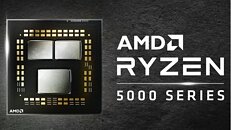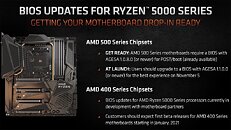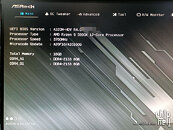Monday, November 9th 2020

AMD Ryzen 5000 Processors Allegedly Work With 300 Series Motherboards
When AMD initially announced that their next-generation Ryzen processors would only support 500 series motherboards they faced significant backlash and were forced to include 400 series motherboard support. The reason AMD cited at the time was the limitations in some flash chips not containing enough space to store the information for all processors, several motherboard manufacturers encountered this issue with Ryzen 3000 bios updates where they needed to reduce graphical elements in their BIOS.
An overclock.net forum user by the name Brko has recently claimed that Zen 3 processors can run on a GIGABYTE X370 motherboard with a beta BIOS and AGESA update. This claim has been partially validated by chm128256m who got a Ryzen 9 5900X to run on his modded ASRock A320M motherboard. AMD is extremely unlikely to officially support this backwards compatibility with 300 series motherboards given their previous statements. It will be interesting to see if any OEMs provide backward compatibility updates and any issues that may arise.
Sources:
Brko (overclock.net), chm128256m (chiphell.com)
An overclock.net forum user by the name Brko has recently claimed that Zen 3 processors can run on a GIGABYTE X370 motherboard with a beta BIOS and AGESA update. This claim has been partially validated by chm128256m who got a Ryzen 9 5900X to run on his modded ASRock A320M motherboard. AMD is extremely unlikely to officially support this backwards compatibility with 300 series motherboards given their previous statements. It will be interesting to see if any OEMs provide backward compatibility updates and any issues that may arise.



33 Comments on AMD Ryzen 5000 Processors Allegedly Work With 300 Series Motherboards
www.asrock.com/mb/AMD/A320M-HDV%20R4.0/index.asp
I have an older board: (Now everyone knows I'm a cheapskate)
www.asrock.com/MB/AMD/A320M-HDV/index.asp
Support link says both latest bios support:
1. Update AMD AGESA Combo-AM4 PI 1.0.0.6
2. Supports 3RD Gen AMD Ryzen XT series CPU
I wonder if AMD would remove support though (in the future)?
And a funny fact... 3xx chipset has NOTHING to do with power! The board's VRM does!
So what is your point exactly?
This is kind of the same as Intel's 9900K was running on Z170 motherboards. Interesting but ultimately pointless.
And thanks for telling us VRMs matter a lot, care to point the difference between the best VRMs on x370 vs x570 then :rolleyes:
And VRM is the only thing matters when it comes to CPUs' power-consumption. Chipset does not.
So if you want to suggest that 3xx chipsets are incompatible becausethe 5000 series' power-consuption, that is utter BS.
It is because AMD pretty much demands, that if you want to make a AMD motherboard, you have to comply with the minimum they require. So a capable VRM that is up to 150W or so.
www.techpowerup.com/review/amd-ryzen-9-3900x-tested-on-cheap-b350-motherboard/
There you have it. The days of the FX era where boards where'nt capable of running a high-end FX are long gone. And yes, a VRM "can" run up to 130 degrees, it's just not very healthy for the surrounding components such as capacitors as it greatly reduces it's lifespan. If your deciding to run a 50$ board with a high-end CPU, it's perfectly possible, but the chances are great your running into thermal issues. Could be solved simply by either extending it's cooling or have a VRM setup that evenly distributes the power as much as possible for best efficiency.
Like again; if you buy a ultra high-end board now these days and paying 500$ for it; you gotta be a bit weird for doing so if it's just for the VRM. In most cases, you won't be even close to the designed maximum of the VRM and not even on LN2. Your better off with a decent board that for example, allows you to play with VRM switching frequency rather then voltages or maximum current. I've seen much better results in OC'ing with just adjusting it's VRM Frequency (how many times it goes on and off a second) rather then loading up a higher voltage.
A good stable voltage that goes from idle to high load and stays the same without huge flutucations is far better then just booting another higher voltage in it.
Anandtech measured 9W more peak power draw (peak != full load power draw) between the 5950X and 2700X which is supported by all 300 series chipsets. My Asrock X370 Taichi runs my 3900X absolutely fine (it folds most of the day so high power draw for long periods) and has a slightly higher power draw than the 5950X.
I don't get people's obsession with ridiculously oversized power delivery systems in PC hardware. It is purely marketing driven, both AMD and Intel set clear power delivery requirements for their sockets that board manufacturers have to meet to be able to certify the board is compatible. Unless you are planing to do big OC's, you can comfortably rely on an AM4 board to run any compatible CPU from a power handling perspective. The FX debacle came about because AMD released a processor that sat far outside the AM3+ power spec (it used 220W TDP) which meant only certain boards could support.
When you go lower in temperature as well; the power requirement drops significant. So there's no real benefit into driving a VRM with up to 900 Amps or so for a CPU that would not in it's lifetime ever consume that. You cant cool that either without going LN2 because the heat density is like the sun on microscopic levels. Same applies for GPU's pretty much.
Since chipset these days is housed into the CPU and no longer on boards, there's not much of an addition like you had in the past. You could go for VIA which was a cheap chipset, or you could go for Nforce 2 or Nforce 3 for that matter, but that would only give you that additional benefit if you knew how to extract that. I mean buying a expensive as shit board is'nt going to make your system perform faster. The difference is that you have alot more tools to for example, improve your overclock or iron out the stability you could have in an OC.
Mweh.
Perhaps it is just me but I was able to kill the VRMs on my first Zenith Extreme II mobo and it so happens that Asus released a revision shortly after the release, called the Zenith Extreme Alpha, with you guess it, better VRMs.
hwbot.org/submission/4308294_rageset_cinebench___r20_ryzen_threadripper_3960x_15119_marks
Wait, no they are more Badass
If u buy an Intel u know 2x Gen and u have to buy a new Board
If u bought an X370, B350, A300 and thought AM4 would be have a long time support, AMD is trolling u and say no:roll:
If the 300 series chipset won't get an update it's purely for marketing reasons, full stop.